Spotlight
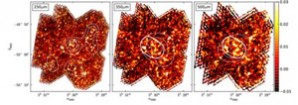
Searching Back in Space for Galaxy Proto-Clusters
Using Steward and space observatories, Steward Observatory Assistant Astronomer Brenda Frye and former Steward Astronomer Hervé Dole have discovered vast complexes of galaxies in the distant universe. Galaxies such as our own Milky Way are usually found near other galaxies in groups or in some cases even in large clusters of galaxies. The galaxy clusters we see today tend to have only older, less active galaxies. Understanding the puzzle of how these galaxy clusters formed and evolved into the relative state of retirement at this present time in cosmic history is a key question in cosmology. Now, using the Planck satellite’s unique ability to produce an all-sky survey of the universe (instead of looking at just one patch of sky as with a ground-based telescope), Frye and collaborators are able to find the earliest examples of these extremely rare and massive galaxy clusters. What is interesting is that all the galaxies in these ‘baby clusters’ are forming stars at the same time, similar to what happens when one plugs in the Christmas lights and the tree gets suddenly bright. It appears that the galaxies in these clusters are not pacing themselves as one would aim to do in a marathon, but rather are using up a substantial amount of energy at the beginning of the race. They ‘turn on’ their Christmas lights all at once, and then later run out of fuel. In a handful of cases they found only a single extremely bright galaxy instead of a whole cluster of galaxies. Frye explains, “This is odd as a single galaxy should not be bright enough to see even with Planck. Understanding how one galaxy can be detected is one of the mysteries that is being solved here at UA”. The answer appears to be that these objects are seen through natural telescopes in space in addition to being seen by Planck. “These natural telescopes take the form of entirely unrelated galaxy clusters near to Earth which bend the light of these distant sources.” Frye observes these special cases with such ground-based telescopes such as the Large Binocular Telescope and the MMT to learn more about these new and enigmatic objects.
A press release can be found HERE and a similar popular article can be found HERE.
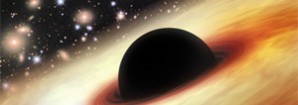
Most Luminous Quasar in Early Universe
An international team, led by astronomers at Peking University of China, and Steward Observatory, including Regents' Professor Xiaohui Fan, visiting graduate students Feige Wang and Jinyi Yang, assistant astronomer Ian McGreer and LBTO support astronomer David Thompson, have discovered the most luminous quasar yet known in the early Universe. This quasar, at a redshift of 6.3, or a distance of 12.8 billion lightyears, is powered by a supermassive black hole with an estimated mass of twelve billion solar masses. The existence of such massive black holes in the early universe posts significant challenges to the theory of black hole growth and its relation to galaxy evolution. The team used Steward facilities, including MMT, LBT and Magellan, for the measurements of quasar distance and the mass of the black hole.
The UANews article can be found HERE. A sky&Telescope article can be found HERE. And now a CNN article can be found HERE. And for a short while, it's one of the four revolving front-page stories at the UA Homepage.
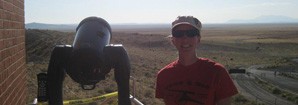
Decker French named ARCS Foundation Scholar
Graduate Student Decker French has been named of of 17 ARCS Foundation Scholars for 2015-2016. She will receive her award and stipend and travel grant on April 17. for more information, go HERE. We join Steward Dept. Head Buell Jannuzi in congratulating Decker.
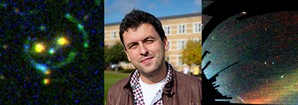
Announcing the 18th Marc Aaronson Memorial Lecturer
The Aaronson Committee has met, and it's our pleasure to announce that our 18th Marc Aaronson Memorial Lecturer is Vasily Belokurov of the Institute of Astronomy, in Cambridge, UK. Buell Jannuzi has telephoned Dr. Belokurov, and Dr. Belokurov has accepted with great pleasure. We are shooting for a Fall 2015 talk.
Dr. Belokurov is cited for his long-term work on discovery of Milky Way dwarf galaxies, on being astronomy's premier data miner, for his work on star streams culminating in the Field of Streams, for his work (with students) on the structure and size and density distribution of the Milky Way from BHB stars, on discovering gravitational lenses in the Cassowary Survey, and on data mining to discover metal-poor dIrr galaxies from SDSS imaging (with MMT followup). To put things in perspective, of the sixteen or so ultra-faint galaxies orbiting the Milky Way, Dr. Belokurov has been on the discovery papers of ~10 (mostly as first or second author).
You can learn more about this award in the paragraph below and at http://en.wikipedia.org/wiki/Marc_Aaronson_Memorial_Lectureship
The Marc Aaronson Memorial Lectureship was established to honor our Steward Observatory colleague who died tragically in 1987 at the age of 36. In his spirit, we honor an individual, within 15 years of the PhD, who by his or her passion for research and dedication to excellence, during the ten years preceding the award, has produced a body of work in observational astronomy which has resulted in a significant deepening of our understanding of the universe." [Since Marc was 10 years past his PhD at his death and had already been on the cover of Time Magazine, a few years ago we changed the rules to guarantee a younger person.]
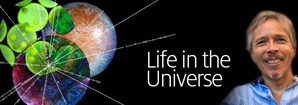
Life in the Universe Lecture Series: Dr. Chris Impey
As part of this year's College of Science Lecture Series, our own Professor Chris Impey is speaking on Monday night March 9. Don't forget, this series is insanely popular, so get there early.
Christopher D. Impey, University Distinguished Professor, Astronomy
Intelligent Life Beyond Earth
One question rises above all others when it comes to our place in a vast and ancient Universe, 'Are we alone?' With a billion habitable locations in the Milky Way galaxy, and more than ten billion years for biological experiments to play out, a search for intelligent life beyond Earth is well-motivated. Unfortunately, the single example of life on Earth gives no clear indication of whether intelligence is an inevitable or an extremely rare consequence of biological evolution. The search for extraterrestrial intelligence, or SETI, is more appropriately called the search for extraterrestrial technology. So far, the search for intelligent aliens by their electromagnetic communication has met with half a century of stony silence. It's challenging to define life, and even more difficult to make general definitions of intelligence and technology. We'll look at the premises and assumptions involved in the search, the strategies used, and the profound consequences of making contact.
For more information, go HERE
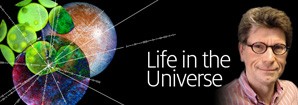
Life in the Universe Lecture Series: Dr. Laird Close
As part of this year's College of Science Lecture Series, our own Professor Laird Close is speaking on Monday night March 2. Don't forget, this series is insanely popular, so get there early.
Laird M. Close, Professor, Astronomy/Steward Observatory
Amazing Discoveries: A Billion Earth-like Worlds
Laird's Abstract: "One of the most fascinating developments in the last two decades is humankind's discovery of alien worlds orbiting stars near our Sun. Since the first such discovery in 1995 there has been a truly exponential growth in the detection of these new planets. Scientists have been puzzled and surprised by the diversity and extravagance of these new extra-solar systems. For example, we now know the most common type of planet is actually missing from our own Solar System. Recently, the space-based NASA Kepler Mission has discovered thousands of new worlds and suggests that one in five Sun-like stars may harbor an Earth-like planet. We will take a grand tour of some of these amazing new worlds, specifically noting where life might already exist, beyond our Solar System. The latest developments and difficulties of direct imaging for life on an exoplanet will be discussed."
For more information, go HERE
Pages

For Public
Public events include our Monday Night Lecture Series, world-reknowned Astronomy Camp and Mt Lemmon Sky Center.

For Students
A good place to start if you want to become an undergrad major or grad student, or need to find our schedule of classes.

For Scientists
Find telescopes and instruments, telescope time applications, staff and mountain contacts, and faculty and staff scientific interests.




